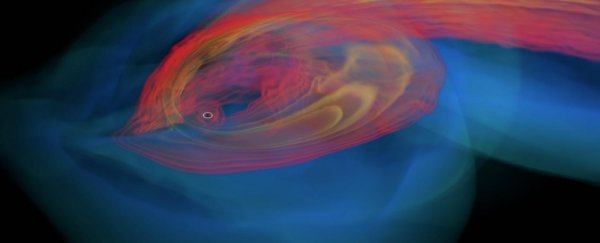When a star ventures a little too close to a black hole, we know - broadly - what happens. The intense tidal forces tear the star apart in what is called a tidal disruption event, unleashing a final burst of light before the star's debris passes beyond the event horizon.
The precise details of this devouring have been a little harder to pin down. Theoretically, the debris should coalesce into a disc as it circles and falls onto the black hole - but most of the tidal disruption events (TDEs) we've managed to observe show no evidence of the X-ray emission that can establish the presence of this accretion disc.
"In classical theory, the TDE flare is powered by an accretion disc, producing X-rays from the inner region where hot gas spirals into the black hole," said astronomer Tiara Hung of the University of California Santa Cruz.
"But for most TDEs, we don't see X-rays - they mostly shine in the ultraviolet and optical wavelengths - so it was suggested that, instead of a disc, we're seeing emissions from the collision of stellar debris streams."
That has led some astronomers to speculate that a stellar tidal disruption event is too brief for an accretion disc to form. But new research has shown otherwise. Using optical and ultraviolet observations of a tidal disruption event, astronomers have found clear evidence of the shifting light expected for a rotating accretion disc.
"This is the first solid confirmation that accretion discs form in these events, even when we don't see X-rays," said astrophysicist Enrico Ramirez-Ruiz of UCSC.
The disruption event in question took place in the centre of a galaxy called 2MASS J10065085+0141342, 624 million light-years away.
Towards the end of 2018, astronomers spotted the telltale flare indicating the supermassive black hole therein was disrupting a star, and the researchers tuned in to watch in multiple wavelengths as the light evolved. They named the tidal disruption event AT 2018hyz.
They were later able to calculate that a supermassive black hole around several million times the mass of the Sun had disrupted the star. But there was something else in the spectroscopic observations, too - a double peak in what is known as Balmer emission, generated when electrons in hydrogen atoms transition to a lower energy level.
"My jaw dropped, and I immediately knew this was going to be interesting," said astrophysicist Ryan Foley of UCSC, who spotted the strange signature. "What stood out was the hydrogen line - the emission from hydrogen gas - which had a double-peaked profile that was unlike any other TDE we'd seen."
This double peak of broad Balmer emission in an active galactic nucleus is interpreted as evidence of an accretion disc. Where these lines fall in the spectrum can show evidence of motion in their Doppler shift.
Waves of light that are emitted from something moving towards us are shortened towards the blue side of the spectrum, or blueshifted. But light waves from a receding object are lengthened, or redshifted. You can see examples of both in the diagram below:
When you're looking at something like a disc from just the right angle, you'll see evidence of both of these shifts - blueshift from the side rotating towards you, and red from the side rotating away. It can be used not just to determine rotation, but the velocity of that rotation.
"I think we got lucky with this one," said Ramirez-Ruiz, who in 2018 co-authored a paper presenting a unified model for tidal disruption events.
"Our simulations show that what we observe is very sensitive to the inclination. There is a preferred orientation to see these double-peak features, and a different orientation to see X-ray emissions."
As AT 2018hyz continued to evolve over the course of several months, the team continued to take multi-wavelength observations, comparing them to other TDEs, as well as simulations and models.
They determined that the accretion disc was made up of around 5 percent of the star's initial mass - and that it had formed incredibly quickly, within the span of a month.
The team's interpretation of a disc origin for the double-peaked Balmer emission doesn't stand alone. Independently, an international team of researchers led by astronomer Phil Short of the University of Edinburgh in Scotland reached the same conclusion.
In a pre-print paper submitted to the Monthly Notices of the Royal Astronomical Society, Short and his team note that "AT 2018hyz is the first TDE in which clear, double-peaked emission lines have been observed and provides strong observational evidence that accretion discs form in at least some TDEs and are a significant source of the observed luminosity".
There are still mysteries to be solved, though. Short and his team note that the double peaks only appeared briefly before fading, and they don't know why. Additionally, Hung and her team call attention to the absence of the double peaks in other TDE observations.
Both groups suggest that we might do well to pay closer attention to TDEs in the future.
Hung's team's research has been accepted into The Astrophysical Journal, and is available on arXiv.

